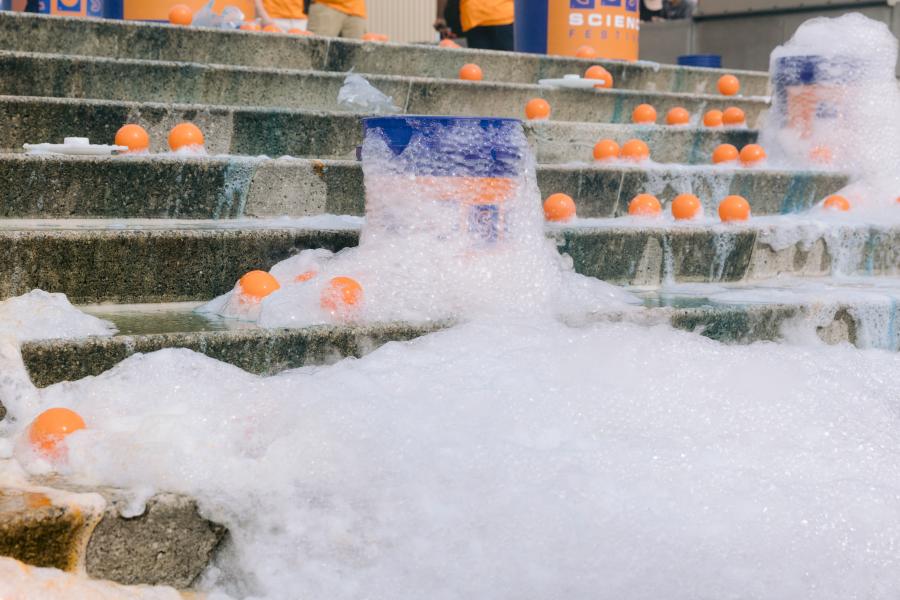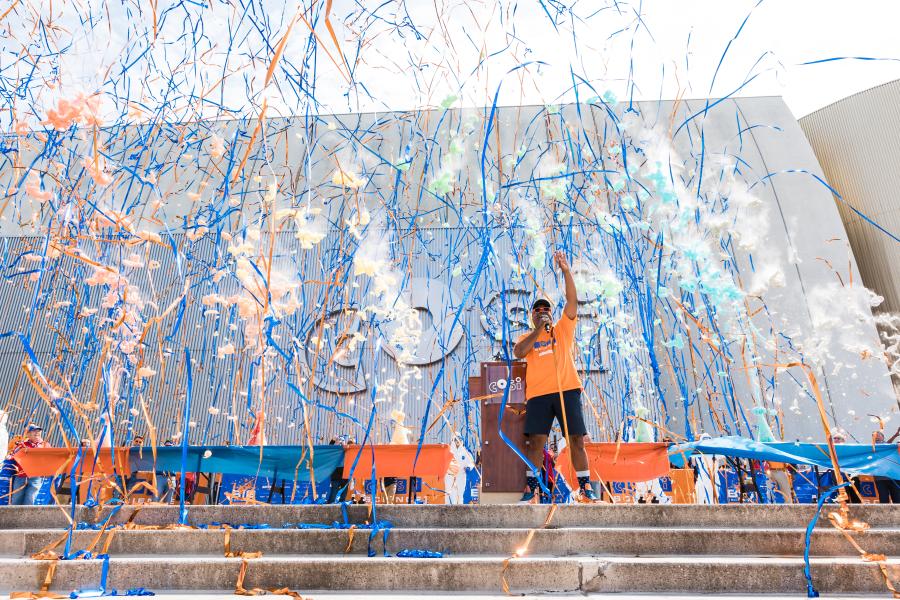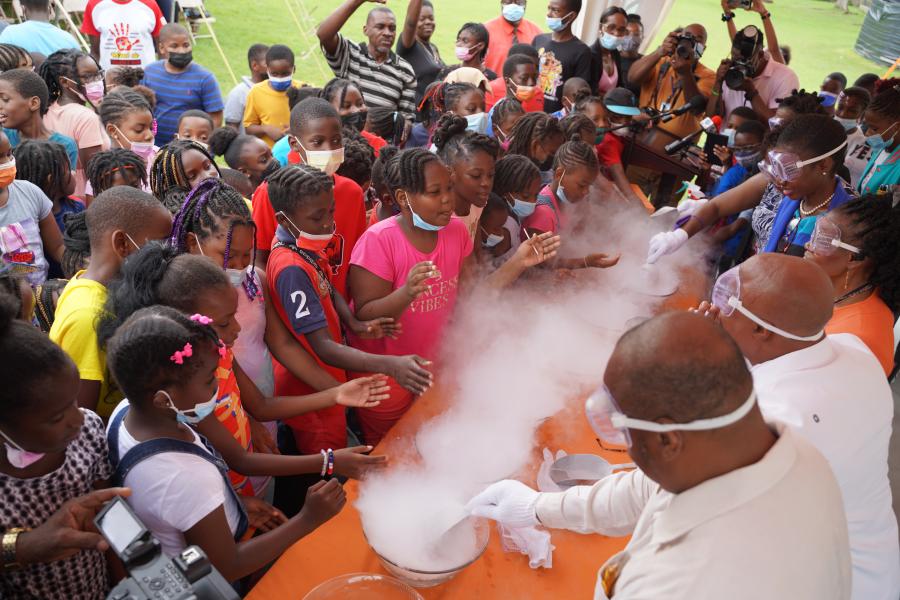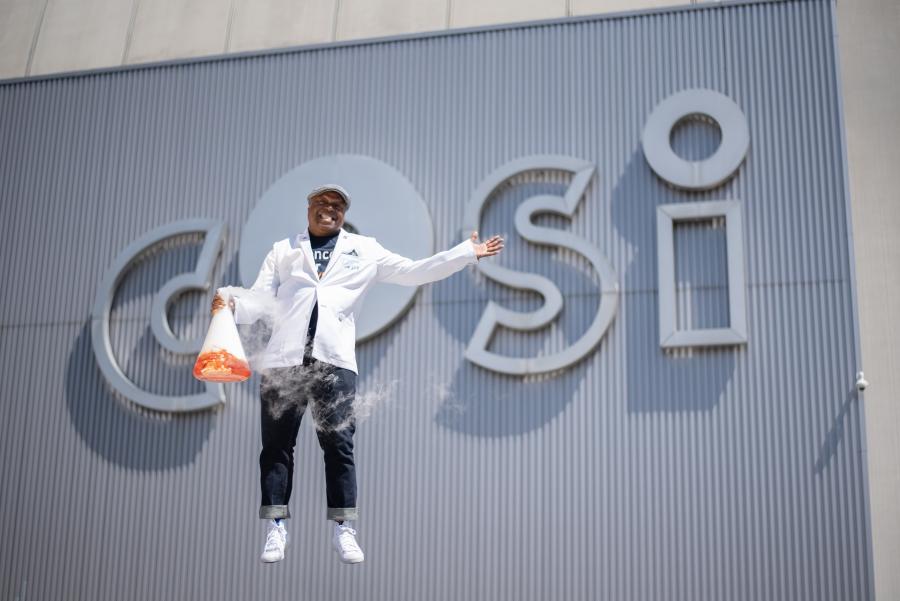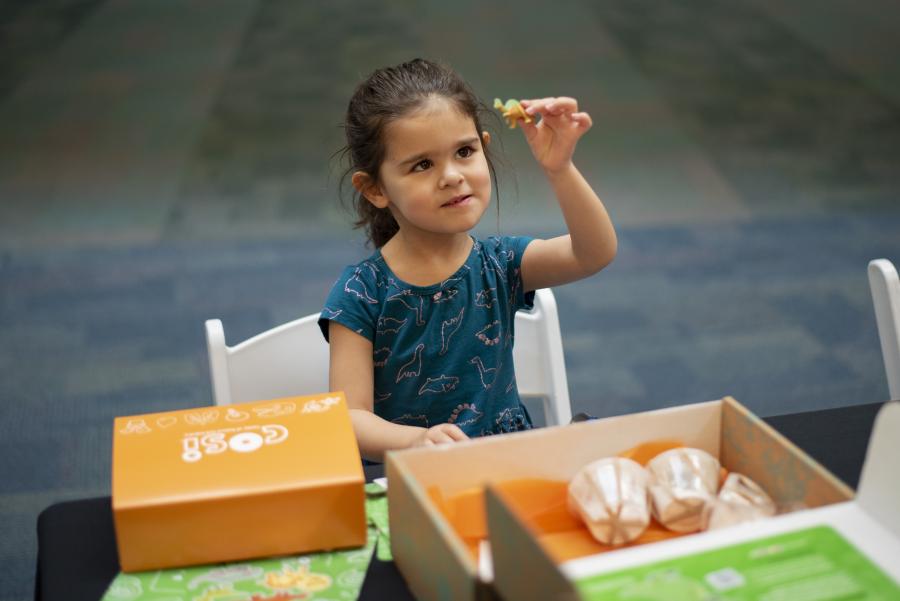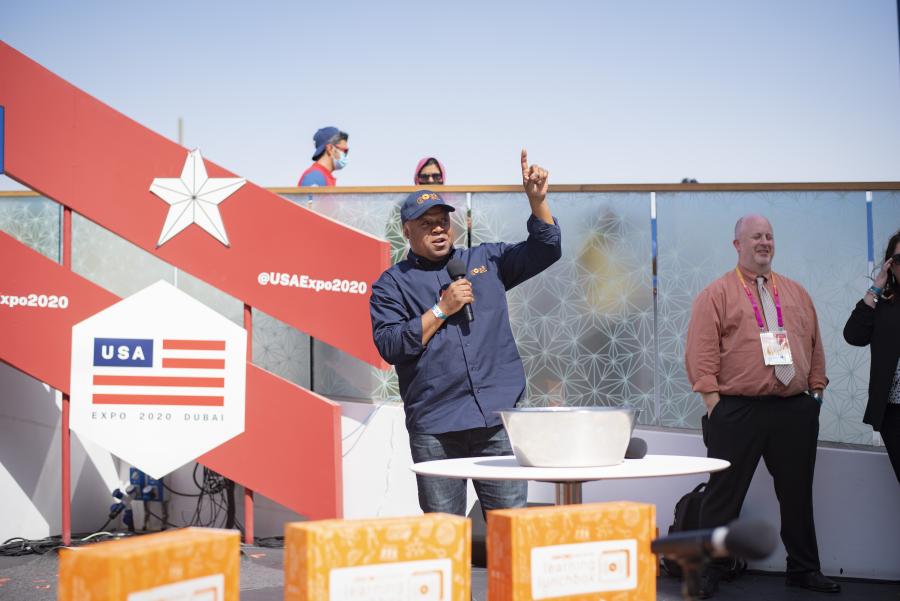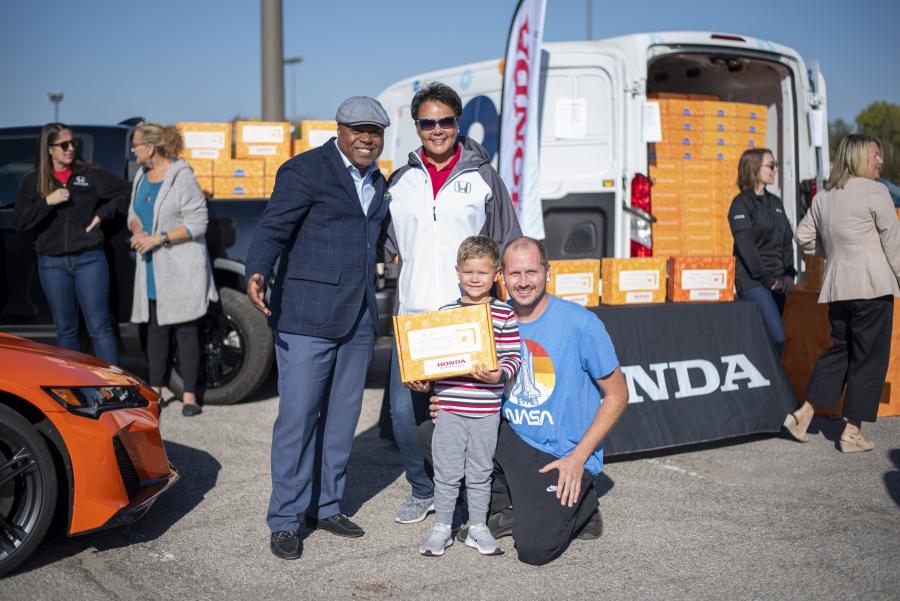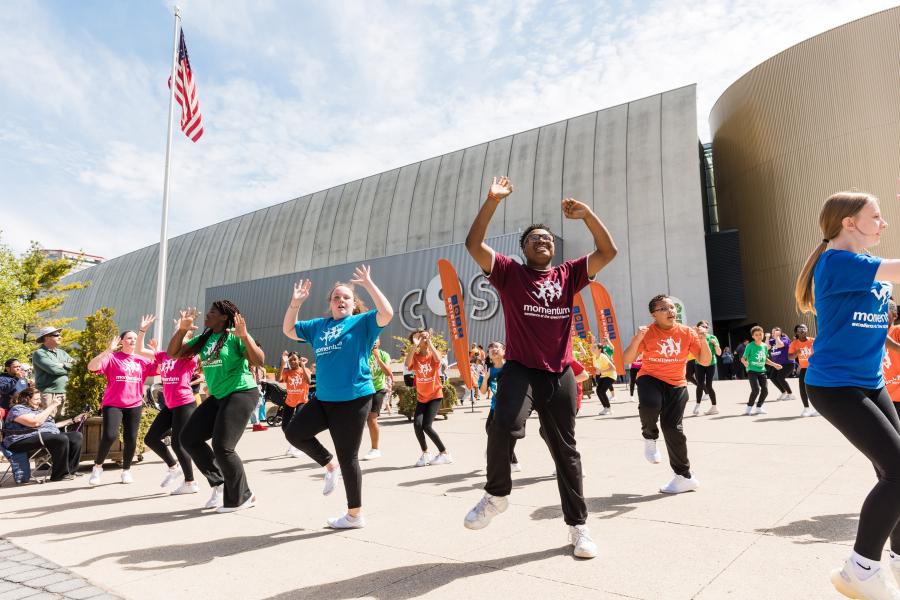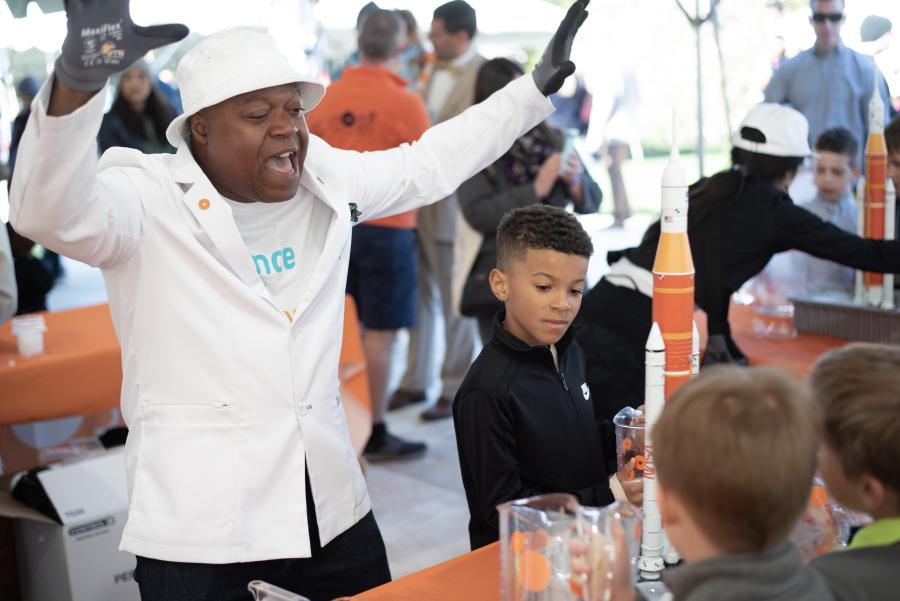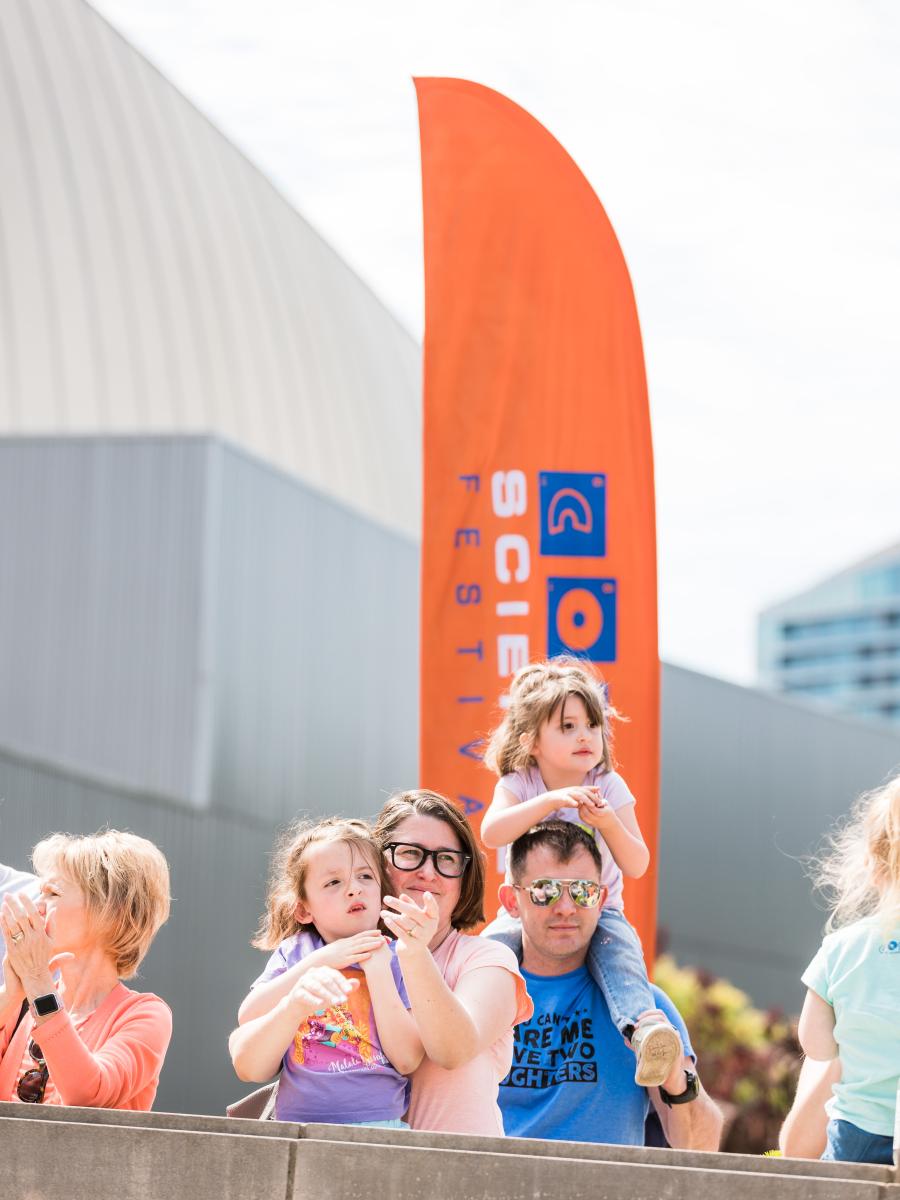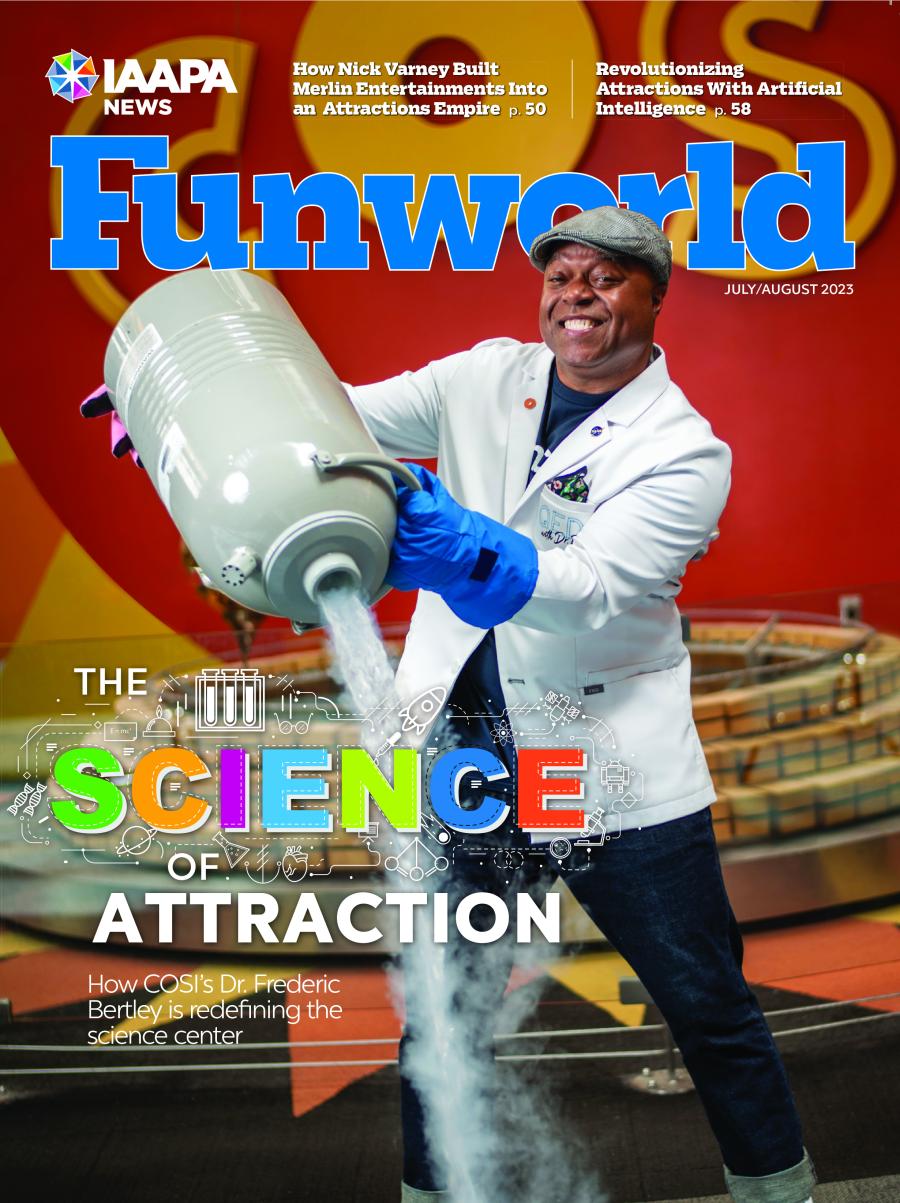Under blue skies on a Saturday in May, Dr. Frederic Bertley struts across the steps of the Center of Science and Industry (COSI) in Columbus, Ohio. Behind him: COSI’s futuristic façade designed by Japanese architect Arata Isozaki. Before him: hundreds of children hanging on his every word. Bertley is not only the president and CEO of the storied science center—he’s also a master behind the mic.
“Science is everywhere, and science is for everyone,” is his personal mantra.
Dressed in a bright orange shirt, blue golf shorts, and his trademark Chuck Taylor Converse shoes in COSI’s Pantone orange, Bertley sounds like a stadium emcee at a professional sporting event. Yet, he’s a trained scientist turned attraction leader.
Part pep rally, part community event, and part open house, COSI’s annual Big Science Celebration event is a blast—literally. With Dr. B (as he is affectionately known) giving the cue, science center staffers dressed in boilersuits set off coordinated chemical reactions that discharge multiple controlled explosions, resulting in colorful foam bursting skyward that delights visitors and creates a communal connection.
“It’s a science experience,” Bertley says of the public display that COSI will replicate in places where people gather. “We’ll be in your synagogue, we’ll be in your church, we’ll be in your community center, we’ll be in your backyard. We’ll show you that your cookout is a place where people can get excited around science—especially around alcohol and beers.”
The resulting enthusiasm for taking science outside the traditional museum is contagious, with curiosity quickly manifesting through smiles and cheers. The rash of positive energy can inspire dreams for all. While the “I” in COSI stands for industry, Bertley says that, to him, the letter also represents imagination, innovation, and inclusion.
“Science and tech are everywhere. So, if it’s everywhere, everyone should have a chance of learning about it,” Bertley believes. His vision for the museum of the future and his passion for people of all backgrounds are a source of energy in the global attractions industry.
Starting Science Early
One word that is not part of Dr. Frederic Bertley’s vocabulary: shy. Any hint of bashfulness is replaced with transparency.
“Just to be clear, so you and I are on the same page, I’m the ‘Oops Baby’s’ younger brother,” he says early in his Funworld interview. “My mom was in her 40s when I decided to come out into this place—not planned—but to the best parents in the world.”
The native of Montreal is the fourth child born to two ambitious parents, a Barbadian mother and Trinidadian father who met while studying at McGill University. Between the pair, his parents earned 11 university degrees from MDs and PhDs to MBAs. Therefore, one may think that following in his parent’s scholarly footsteps was a logical path for Bertley. Think again.
“I thought I was going to play in the National Hockey League,” he says with a grin. Becoming a fireman was a close second. That is, until an early handheld video game changed his career aspirations forever.
Tired of visiting Radio Shack to purchase 9-volt batteries using money earned from delivering newspapers, he opened the back of his handheld electronic Coleco football game, snapped off the battery connector, attached the red and black wire to an old lamp cord found in the basement, and plugged the game into the wall.
“It was the best 10 seconds of my life because it was working. I was like, ‘Oh, my gosh! I’m never getting batteries again!’” he exclaims.
His euphoria lasted only 11 seconds.
“Poof! My cherished game blew up. There was too much energy coming out of the outlet,” he recalls, adding that he realized the electric outlet was charred as his father came running.
“At this point, he’d been living in Canada for 35 years and didn’t use a West Indian accent … unless he was upset. He said, ‘Son! What are you doing? You tried to burn down the house!’”
Scolded, and “bummed” that the burst of power destroyed his game, Bertley’s feelings of loss were quickly replaced with a newfound curiosity.
“You click on a switch, or you plug something in the outlet, and it works, there’s something more magical happening there. And my curiosity was stimulated,” he says. The moment awakened a calling to explore science and appreciate nature. “I just became obsessed with how things work.”
Bertley then mobilized to pursue this question. The mathematics and physiology major switched to immunology after spending three summers doing lab work and completing research for Johns Hopkins University and the World Health Organization while based in Haiti.
Next came research in Sudan, at Massachusetts Institute of Technology, and at Harvard Medical School, followed by a spell dabbling in law while researching vaccine patents. The experience led to The Franklin Institute in Philadelphia, one of North America’s oldest science museums, where Bertley spent nine years, becoming the senior vice president of science in education. During this time, he began taking science beyond the museum’s walls and into the community, in part by creating educational TV shows. The effort led to two Emmy Awards for science programming.
In 2016, his phone rang. COSI’s Board of Trustees recognized his work as an attraction leader and wanted to bring him onto the team. “I didn’t fall out of a truck and get this; I earned the position through hard work, sweat equity, and building a reputation,” Bertley says.
He and his wife then moved west to Columbus, where Bertley’s record of outreach and his PhD in immunology (with a concentration on vaccine development) would soon be of great value as an attraction leader.
Feeding Minds
When attractions shuttered in 2020 during the COVID-19 pandemic, many museums raced to place content online. COSI not only went digital but put a strategy in place to aid teachers and parents trying to instruct their children at home. Bertley’s team aligned the digital lessons posted to COSI.org with Ohio’s Learning Standards and Model Curriculum for Science and the national Next Generation Science Standards. That spawned COSI Connects, the brand name for the ecosystem the science center created for external education.
The museum pushed education further to benefit underserved populations that may not have consistent computer access.
“We took our content and put it inside a box,” Bertley excitedly explains. “We know people want to press a button, do an experiment, and have an interaction.” Under the COSI Connects label, the science center created shoebox-size COSI Connects Kits for purchase and distributed free Learning Lunchboxes. Sensing a growing need in the community, the science center partnered with the Children’s Hunger Alliance to get the Learning Lunchboxes into the hands of children experiencing meal disruptions at 12 mobile meal distribution sites.
“They were giving free food to feed the body. We were giving free mental food to feed the mind. And the idea of ‘Feeding hungry lives and feeding hungry minds’ was born,’” he says of COSI’s pandemic-era slogan. “The poor, urban areas in our great country were sliding even further, especially in STEM. So, we created a solution.”
The lunchboxes contain experiments, puzzles, and tasks centered around science, technology, engineering, and math—along with an experiential surprise: a free ticket to visit COSI.
To produce the Learning Lunchboxes, COSI worked with various agencies within the City of Columbus, Franklin County, and the State of Ohio to defray the cost with grant money. The successful formula of boxing up the attraction then began traveling, touching the lives of more underserved children.
Going the Distance
During the pandemic, Bertley identified a greater need outside the concentric circles of Ohio’s 88 counties. In 2022, he partnered with NASA and the U.S. State Department to distribute Learning Lunchboxes internationally at Expo 2020 in Dubai. The United States pavilion served as a backdrop while Bertley and his team sought to transform lives of underserved youth in the Middle East.
“You’re not doing it for yourself. You’re doing it for the people whom you serve,” he says of taking Learning Lunchboxes global. Since, COSI has distributed Learning Lunchboxes in Florida in partnership with the Orlando Science Center, in Manchester, England, and in his mother’s native Barbados, to name a few.
“Now we’re taking COSI outside of the building and into a box and getting it to many folks,” Bertley says. This also included a partnership with automotive maker Honda to distribute 20,000 Learning Lunchboxes at food banks through the innovative Honda Engineering Roadshow.
“These are lines of business and lines of opportunity that still exist,” Dr. Bertley says of how museums can connect with their community—and beyond. COSI Connects Kits are available for purchase in the science center’s gift shop and on its website. Retailing for $30-$40, more than a dozen kits feature curriculum rooted in dinosaurs, space, water, energy, snow, and even the proposed Hyperloop One.
STEM + STEAM = Wider Appeal
While STEM learning taps into science, technology, engineering, and math, STEAM adds art to the equation. COSI’s limited-time, extra charge, touring exhibits cast a broader appeal beyond traditional science. These “blockbuster exhibits,” as Bertley calls them, have included hosting one of the world’s largest collections of Marvel comics and film memorabilia to this summer’s Tutankhamun exhibit, displaying replica artifacts from ancient Egypt. Six months before a major new exhibit opens, COSI holds an art competition. Categories for elementary school children, middle school students, and adults allow the center to connect with potential guests who have interest in the arts and history.
“For COSI, the concept of having an integrated ecosystem of art and science makes perfect sense,” he says. “What we try to do is provide authentic experiences that really showcase that COSI gets that science is everywhere and for everyone, and that art, creativity, and innovation are parcels of the scientific and engineering enterprise, as well as vice versa.”
Dr. B also appreciates a pop of color. Each year, COSI staffers are presented with a new pair of customized Chuck Taylor-style Converse sneakers to wear to work.
For those outside the kit’s distribution channels, COSI partnered with WOSU, Columbus’ PBS television affiliate, to produce “QED with Dr. B.” Standing for Quite Easily Demonstrated, the program is inspired by Bertley’s commitment to improving science literacy. A second video program, “Dr. B in 3,” turns Bertley into a cartoon avatar of himself where he explains scientific concepts with three simple questions surrounding a complicated, scientific topic. These programs have earned Bertley and his colleagues at COSI an additional five Emmy Awards.
“Being creative and innovative around all these things really pushed the brand forward. And now that we’re open again … guess where they want to take their family or kiddo? They remember, ‘Oh, I had a good experience with COSI.’”
Sourcing Guests
Sitting on the banks of the Scioto River, COSI resides in Columbus’ former Central High School. The renovated and modern structure remains at the core of the attraction, with nine galleries spread across 320,000 square feet of exhibit and special event space home to 300 interactive experiences. Successfully bringing 750,000 visitors through the doors each year happens at COSI when four objectives are met, according to Bertley.
The first is grounded in people and making smart hiring decisions. “I have the best team on the planet. And they know to put people first. We will serve you how you are … no matter how you show up. We will show you the best guest experience we can,” he says of his attitude towards guest service.
Second, Dr. B believes an institution must look and feel authentic. “Don’t try to fake and be something else. We are a hands-on, interactive science center. And we are going to give you the best-in-class, hands-on, interactive experience that we can possibly provide. People sense that,” he says.
Third, he believes a science center or museum needs to layer on making its subject matter interactive, fun, and engaging. COSI guests will find a rack at the exit showcasing brochures for other local cultural attractions. While some attractions leaders may scoff at promoting the competition, Bertley believes attractions are stronger when they collectively promote offerings in the community.
Fourth, he says creativity and innovations must be prominent in messaging and execution.
“Even within your space, in your lane, you can’t do the same old, same old. You got to have new and innovative stuff, so your day visitors and those who bought an annual membership come back. They feel like, ‘Wow, this is important for me to come back here.’”
Scott Fais is IAAPA's director of global editorial and digital content. The Emmy Award winning storyteller loves creative attractions, connecting with thought leaders, and coasting in a water park's lazy river. Give Scott a shout here.
- The above article appeared as the cover story in the July/August 2023 edition of Funworld magazine. To see the magazine in its entirety, click here.


